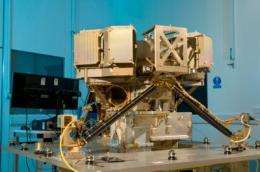The MIRI infrared instrument has two faces

A short new video takes viewers behind the scenes with the MIRI or the Mid-Infrared Instrument that will fly on-board NASA's James Webb Space Telescope. MIRI is a state-of-the-art infrared instrument that will allow scientists to study distant objects in greater detail than ever before.
The three minute and 19 second video called "The MIRI Has Two Faces" is part of an on-going video series about the Webb telescope called "Behind the Webb." It was produced at the Space Telescope Science Institute (STScI) in Baltimore, Md. and takes viewers behind the scenes with scientists and engineers who are creating the Webb telescope's components. MIRI's "two faces" allow the instrument to look at the cosmos in pictures and through spectroscopy.
The James Webb Space Telescope contains four science instruments, but only one of them, the MIRI, sees light in the mid-infrared region of the electromagnetic spectrum. Mid-infrared light is longer in wavelength than that which the other Webb instruments are designed to observe. This unique capability of the MIRI allows the Webb telescope to study physical processes occurring in the cosmos that the other Webb instruments cannot see.
In the video, STScI host Mary Estacion interviewed European principal investigator, Dr. Gillian Wright. Wright explained the benefits of the MIRI's mid-infrared vision, who explained that the instrument is better at seeing through dust which obscures key phenomena such as star formation. It is also better at seeing light emitted by molecules that reveal a wealth of physical information and can reveal the presence of life on other planets.
The MIRI is both a spectrometer and an imager. MIRI contains two apertures that can be pointed at an object in space to record both its image and spectrum. An aperture is an opening through which light travels. The MIRI is basically two instruments in one, so it has "two faces."
MIRI records light with wavelength in the range of 5 to 28 microns. Its sensitive detectors will allow it to make unique observations of many things including the light of distant galaxies, newly forming stars within our own Milky Way, the formation of planets around stars other than our own, as well as planets, comets, and the outermost debris disk in our own solar system.
The MIRI's spectrometer will enable scientists to learn about an object's physical properties, including temperature, mass, and chemical composition. The MIRI's camera will provide images that enable scientists to study an object's shape and structure, and will continue to provide the kind of breathtaking pictures that have made Hubble famous. "The MIRI instrument and the Webb's large telescope mirror will enable the highest resolution mid-infrared imagery ever achieved in space astronomy," said Matt Greenhouse, project scientist for the Webb instrument payload at NASA's Goddard Space Flight Center, Greenbelt, Md.
The MIRI also includes coronagraphs that will enable it to image planets and the process of planet formation around stars other than our own.
The MIRI's components were built by a consortium of 11 European countries and the NASA Jet Propulsion Laboratory. The instrument was assembled and tested at the Rutherford Appleton Laboratory near Oxford, England, and that's where this new video takes viewers behind the scenes.
The Webb telescope is the world's next-generation space observatory and successor to the Hubble Space Telescope. The most powerful space telescope ever built, the Webb telescope will provide images of the first galaxies ever formed, and explore planets around distant stars. It is a joint project of NASA, the European Space Agency and the Canadian Space Agency.
Provided by NASA's Goddard Space Flight Center




















